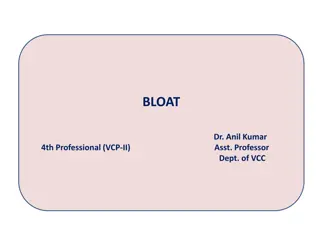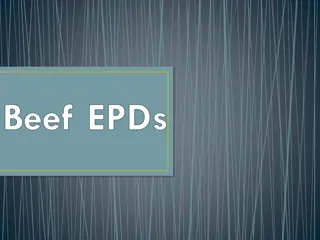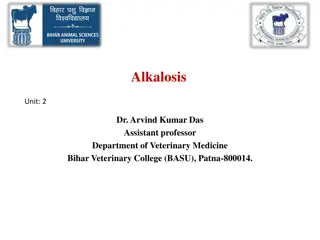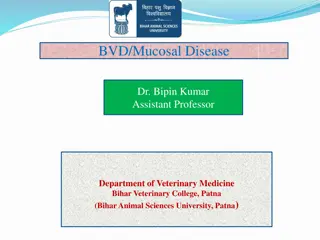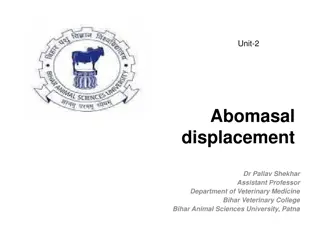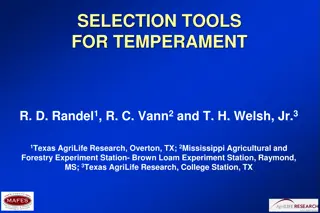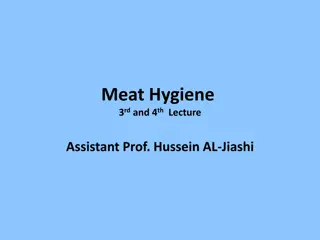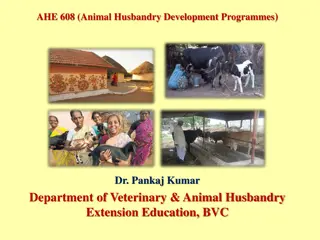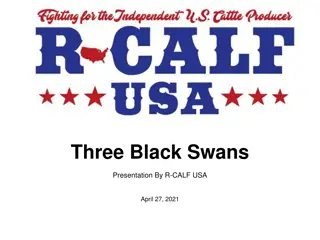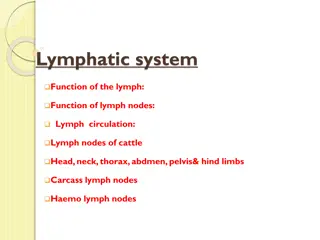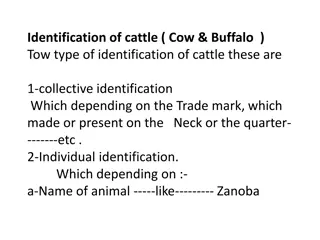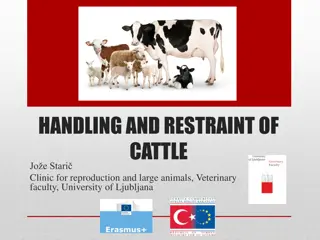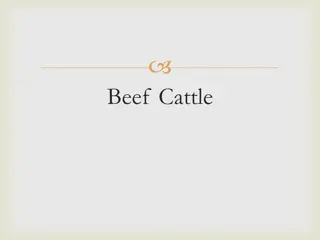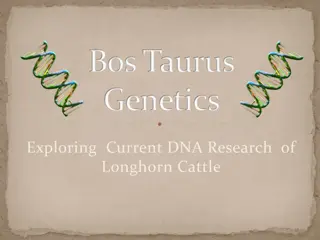Understanding Cattle Management and Classification
Cattle, belonging to the genus Bos, are classified into three types - Bos Taurus, Bos Indicus, and Bos Africans. They are ruminants with fixed hollow horns, udders with four teats, and males have teats on the scrotum. Cattle are utilized for milk production, agriculture, and meat manufacturing. They are grouped based on geographical origins into European, Indian, and African cattle categories. Various terms such as calf and bull calf describe the young ones in cattle farming.
Download Presentation

Please find below an Image/Link to download the presentation.
The content on the website is provided AS IS for your information and personal use only. It may not be sold, licensed, or shared on other websites without obtaining consent from the author. Download presentation by click this link. If you encounter any issues during the download, it is possible that the publisher has removed the file from their server.
E N D
Presentation Transcript
Cattle Management Cattle track Class -----------------------------------Mammals Order----------------------------------Ungulates Family----------------------------------Bovidae Genus----------------------------------Bos
This genus includes all type of cattle ,they are (3) types 1-Bos Taurus------include all European cattle 2-Bos indicus-----include all Indian &Asian cattle. 3-Bos Africans-----include all African cattle.
Cattle are ruminants and have fixed hollow horns not branched and female have udder consisting of (4)part and each part consist teat ,the male stated on the scrotum (4)nipples teats &the cattle used in :- 1-Milk production . 2-Used in agriculture working . 3-Meat production
Cattle are divided according to geographical origin into :- 1-Europeanor cattle or cattle of cold temperate region . 2-Indian&African cattle .
Scientific term :- Calf :-male or female from birth to the weaning
Bull calf :-male from birth until one year old .
Cow :-mature female used in pregnant &production.
Dairy Herd Management Animal milk is economic unit ,feed on material unfit for human consumption and producer food necessary for human consumption with nutritional values &high economic (milk and meat ) . Dairy cattle is of high importance for the following reasons :- 1-High capacity to absorption of a large amounts of fodder crops and other crop residues . 2-The balance between plant and animal farming in term of the role of mutual between the earth &the animal . 3-Estimated manufacturing to high food intake .
Qualities of dairy cattle It is divided into :- A-Formal qualities 1-Udder large &well-formed extended forward and the alliance more than extending it to the bottom . 2-The emergence of vein milk and quality composition . 3-Elongation of the body and the large size of the abdomen &the appearance of bone pinworms . 4-Slender neck & head with harmony . 5-Triangular shape and guided to the body caused by the presence of narrow shoulder &the perimeter was ample and deep abdomen and rear quarters .
B-Productivity qualities More important than the formal qualities include. 1-Milk production . 2-Fat% 3-Age at birth . 4-The length of the milking period and drought . 5-Calm when milking .
Dairy cattle Breeds 1-Holstein-Friesian His Native to the northern parts of the eastern Netherlands * The average weight at birth (35-45)kg . * *The average weight of female (600-700)kg and the bull(750- 1000)kg . *The most common color is black &white ,while the color red and White less . * The average of milk production (5000)kg at 305 days . *The Fat is (3-5.8% ) . *The color of milk whiter than other breeds due to high efficiency in converting the yellow carotene into vitamin A .
2-The Jersey * His native in jersey island of British . The average weight at birth (25)kg. * *The average weight of female (400)kg and the bull(400-600)kg . *The most common color is Brown yellow dun and found white spot. * The average of milk production( 2500)kg at 305 days . *The Fat is (5.35-5.50 % ) . *The color of milk tendency to yellow.
3-The Ayr shire . * His native in (Ayr) country in southeast of Scotland . The average weight at birth (40-45) kg *The average weight of female (450)kg and the bull (650)kg . *The most common color is Red or Brownchocolate with small White spot . . * The average of milk production( 4100)kg at 305 days . *The Fat is (4% )
4-The Brown Swiss * His native in Swiss country . The average weight at birth (40-45) kg. *The average weight of female (600)kg and the bull (725)kg . *The most common color is Dark &pale brown . * The average of milk production( 2570)Lt at 305 days . *The Fat is (4% *
Type of Iraqi cows 1-South cows . 2-Alshrabia cows . 3-Alkurd cows . 4-Alrustakia cows . 5-Crossbreed cows
Dairy Cattle Management The life of dairy cattle are divided in to (3)phases depending on the circumstances ordinary &each phase need to special requirements In terms of administration and care, the care of male differ from female &these phases are :- 1-Calf hood management phase . 2-Pre-mature phase . 3-Maturity phase .
Calf hood management phase This period is begin from the (birth to age at 6 months ). a-The breathing of newborn begin directly after birth &this physiological phenomenon can be summarized as follows :- when cut the umbilical cord (no interruptions circulation of the fetus to his mother or vice versa increase the amount of (co2)in the newborn blood ,which stimulate the respiratory center in the brain which to do homework &his reflex caused by exposure suddenly born to the outer atmosphere .
b-Cut the umbilical cord . After making sure of the safety breathing for the newborn begins to cut the umbilical cord by using sterile scissor & the site of cutting distant from the surface of abdomen about (10)cm , then linking the umbilical by a string sterile and disinfected it by use iodine or antibiotic powder such as sulfa .
c-Drying the body we must be drying the body of newborn after parturition from the allantoises fluid which cover here body by using the clothes or any thing fond in the site due to prevent the cold or respiratory infection .
d-Claws trim . Yellow horny layer on the belly of claws present, can see it after birth in newborn animal ,we must removed this layer to help the animal to stand. the strong newborn can stand on their legs through (20- 30)mints after birth , while the weak newborn standing after(2)hours & needed to help it .
e-The calves directing to breastfeeding . The newborns begin to breastfeeding after (2- 6)hours of birth . Type of breastfed 1-Natural breastfed . 2-Artifical breastfed .
The pre-mature phase This period begin from age (6)months to the first parturition for the animal (2.5-3)years ,this phase include :- *The maturity age of cattle (first estrus cycle ) at age (8)month old . *The time of mating at age (1.5-2)years . *The period between two estrus cycle (21)days ,the estrus cycle appear during the night or in the early morning . *The estrus cycle extended (9-28) hours . *The gestation period in cow (9)months or (271)days .
Sign of estrus cycle 1-Restlessness &standing while the other animal quite casting . 2-The cow jumping on other animal if it free . 3-Shaking the tail &rise it up . 4-The animal prevented from eating and decrease in rumination . 5-Descnt of urine as drops and increase the urination . 6-congestion of the mucous membrane lining the vagina with the descent of transparent mucous discharge from the vulva. 7-Regular intervals voices exited from the animal .


